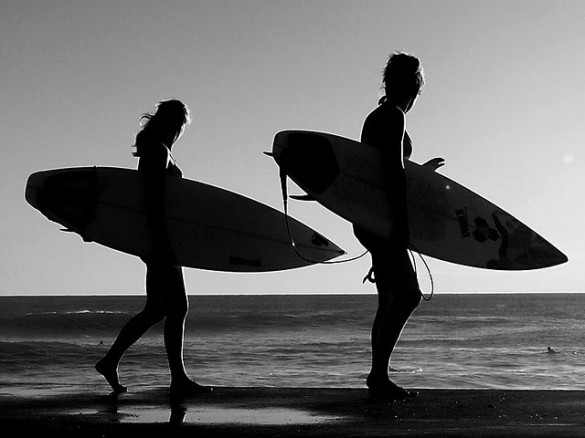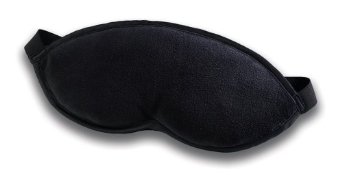
One night in a dream, a tall and attractive man appeared outside my house wearing a naval officer’s uniform. I distinctly remember his blue jacket and white cap. He was a stranger, and yet I felt I could trust him. I let him in and he stayed to talk to me for a long time. Although I couldn’t remember our conversation, later that night I suddenly found myself practicing this technique:
I go back to sleep mindfully with the intent to have a lucid dream. I visualize a surfer picking up her board and then walking into the ocean holding it against her. She (I) walks through the surf—breathing in… the tide receding… breathing out… the tide flowing onto the shore.
Now mentally immersed in the scene, I see the surfer spreading herself across the board and paddling out toward the open sea, the motion of her arms the rhythm of my heartbeat. I equate the bed my body is resting on with the water beneath the board becoming ever deeper and softer.
[pullquote]The more real I make the experience, the more effective the technique seems to be.[/pullquote]
Then, where the two opposing currents meet—waves flowing toward the shore and the waking world vs. the irresistible undertow pulling my thoughts into the dark depths of sleep—the surfer spreads herself across the board of her intent and observes the hypnagogic waves, frothing with images, waiting for the one she senses might be consciously surfed into a lucid dream.
Remaining mentally awake long enough to ride the hypnagogic waves dramatically increases the odds that once I fall asleep, I’ll be able to raise my head above a dream’s subconscious currents and declare — I’m dreaming!
The Surfer Technique is so much easier, and so much more fun, for me to practice on a nightly basis than concentrating on my breathing while focusing on successive parts of my body in an effort to relax. I totally lose patience with that, whereas I always enjoy deepening the surfer visualization by adding more sensual details—the temperature of the water, the feel of the ocean spray on my face, and so on.
The more real I make the experience, the more effective the technique seems to be.

I also sometimes wear a sleep mask after four-o’clock in the morning, when lucid dreams are more likely to happen. I found this particular mask on amazon: the Clark Comfort Eye Mask— it is quite comfortable; I have no problem falling asleep with it on as its gentle pressure helps focus my intent.
Wearing a sleep mask eliminates the concern my eyes will open—the board tipping over—and abruptly return me to the waking world.
Once awake in a dream, physical sensations help anchor my lucidity. I quickly touch different parts of my body, stripping off pieces of clothing if necessary, and plant my bare feet on the floor. I employ the classic technique of periodically raising my hands in front of my face and either thinking or saying out loud I’m dreaming.
It also helps me sustain lucidity when I keep looking around me instead of focusing for too long on one object, person or activity. Even when engaged in a conversation, every now and then I’m careful to look away from the dream character’s face.
Like a whale coming up for air, my Inner Self has the power to regularly rise up from the dark depths of sleep and take in the joyfully clear, life enhancing atmosphere of a lucid dream.
Author Bio
 Maria Isabel Pita has traveled extensively and authored critically acclaimed paranormal, contemporary and historical romances in addition to the historical epic Truth is the Soul of the Sun-A Biographical Novel of Hatshepsut-Maatkare and the best-selling Kindle Single A Concise Guide to Ancient Egypt’s Magic and Religion.
Maria Isabel Pita has traveled extensively and authored critically acclaimed paranormal, contemporary and historical romances in addition to the historical epic Truth is the Soul of the Sun-A Biographical Novel of Hatshepsut-Maatkare and the best-selling Kindle Single A Concise Guide to Ancient Egypt’s Magic and Religion.
Her lucid dream-related articles have been published in the Lucid Dream Exchange and her site Ancient Omnivore.
First Image Credit: Surfer Girls by PinCheck
What I love about your method Maria is how it shows a unique — but repeatable — path to relaxation and mental vigilance while sleep deepens to induce a lucid dream. Inspiring!
I’ve tried holding on to hypnagogic imagery before, and it doesn’t work. As long as I recognize it as hypnagogia, I don’t fall asleep. It is simply impossible to cross the threshold of sleep and remain aware, at least for me. I am getting better at not being fooled by hypnagogic imagery, however.
Hi Morgan –
It’s definitely not easy to surf the hypnagogic waves. Like actual surfing, it takes a lot of practice and time, but if you feel it’s not your thing, there are many other ways to enjoy the ocean!
For me a WILD (wake induced lucid dream) happens very rarely, and when it does, I don’t try and hold on to the imagery, I simply observe it, let it flow past me like a river, allowing my awareness to just go with the visual current, and sometimes I end up immersed in one of the scenes. Most of the time I simply fall asleep.
I’m not sure what you mean about not being fooled by hypnagogic imagery. Fooled in what way?
I think one thing that is hindering my ability to go lucid is that every time I post a comment to this feed it never shows. It tells me it was published, but doesn’t show. This is very traumatic to my dreaming mind, something I couldn’t possibly face in a lucid scenario.
I’ve tried to extend the period of hypnagogic imagery prior to falling asleep. Sometimes I see the web-like interference and the image behind it. I can even go through the web into the scene at times, but it doesn’t last much longer than that. I’m looking forward to trying the surfer technique. It seems so natural that it should work.
Hi William – Catching one of those cresting scenes and riding it into a dream IS really difficult. One time I remained conscious long enough to imagine my hands reaching into the scene and actually taking hold of an object with my hands, which enabled me to “pull” myself into the dream, rather like the metaphorical surfer grabbing hold of the board and stepping onto it just in time to ride a wave. I then sustained the lucidity by attempting to shape the object in my hand, which happened to be a stuffed animal, into a living animal.
Good luck with the waves! As I mentioned, this technique was given to me by a dream character, although it’s more accurate to say I wordlessly downloaded the information and then just suddenly found myself practicing the technique later that night.
I’ll be trying this method for a few weeks, I love to surf and like the sound of it, but had never thought of it. Thanks for sharing Maria.